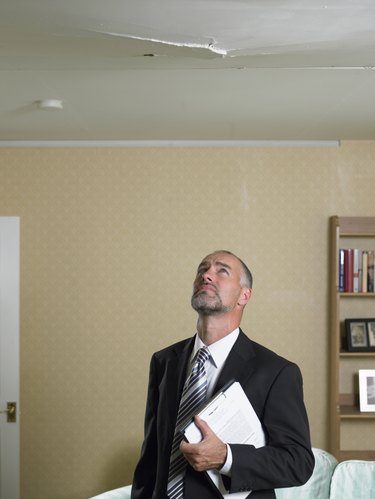
If you're hanging drywall on new ceiling joists, you probably won't need furring strips. Standard drywall panels attach directly to the joists with drywall screws. If the ceiling is old, however, and you don't want to remove the existing ceiling finish, furring strips can provide a solid base. But be aware that you'll lose some ceiling height if you use them.
Reasons for Furring
Video of the Day
Although ceiling joists are generally sufficient for installing drywall, there are a few instances when you can benefit from furring. If the existing ceiling is plaster, if it's cracked or sagging or if it has many thick layers of wallpaper, furring strips will secure the existing ceiling and give you a base for the drywall. Open ceiling joists that have wiring attached to the bottom of the joists, which is often seen in basements, require furring before you can install drywall.
Video of the Day
Furring Process
Furring a ceiling involves adding strips that provide a secure base to hold the drywall. While you can purchase furring strips in bundles of boards that are 8 feet long and 1 to 3 inches wide, you can use lumber in other dimensions to fur out a ceiling. The general rule is to install furring strips that are the same width as the ceiling joists. If the ceiling joists are 2-by-6 lumber, you'll use boards the same width as the joists, which are actually only 1.5 inches wide. Use a screw gun and framing screws to attach the strips securely through the existing ceiling and into the joists.
Cutting Furring Strips
If you're attaching the strips to accommodate wiring or plumbing elements that extend below the original ceiling joists, you'll have to cut the furring strips so that they don't press on the wires or pipes. The simplest way to do this is to measure from the end of a joist to the wires that cross it. Cut and install a furring strip that is a half inch shorter than the measurement. Do the same thing on the other side. Small gaps in the strips won't make a difference when you install the drywall panels.
Attaching Drywall
The standard method of hanging ceiling drywall is to position the panels perpendicular to the joists, which will also be perpendicular to the furring strips. Because the strips act as the frame to hold the panels, use drywall screws that are an inch longer than the thickness of the panels. For example, if the drywall panels are a half-inch thick, use 1.5-inch screws to attach the panels to the furring strips.